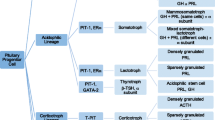Abstract
Pituitary adenomas most commonly are identified as small, incidental microadenomas. They however may progress to macroadenoma forming intra and later suprasellar tumors which in about 1/3 of cases invade surrounding structures at the time of diagnosis. Mechanism of pituitary tumorigenesis remains still elusive. Because the value of karyotyping is limited by the technical problems related to cytogenetic methods, we studied the spectrum of chromosomal imbalances associated with pituitary adenoma using comparative genomic hybridization (CGH). Copy number aberrations on all 22 autosomes were evaluated by CGH using advanced computer software. In total, fifteen patients were included in the study of 9 non-invasive, 4 invasive and two recurrent adenomas. The mean age of the patients were 48 years ranging from 36 to 68 years. Five tumors showed hormonal activity. The histogram of all 15 cases representing the DNA imbalances as an incidence curve along each chromosome showed losses particularly for chromosomes 1p, 2q, 4, 5, 6, 11q, 12q, 13q and 18q as well as overrepresentation on 9q, 16p, 17p, 19, 20q. Functioning adenomas carried more imbalances than non-functioning, specifically deletions on chromosome 4 and 18q as well as overrepresentations of chromosomes 17 and 19. Invasive adenomas carried more overrepresentations at 1p34 than non-invasive tumors. Recurrent adenomas harbored more alterations than primary tumors, particularly DNA gains. The primary data is accessible at our CGH online tumor database at http://amba.charite.de/cgh. Reviewing the existing literature on the genetics of pituitary adenoma and discussing our results in this context, we hope that our study will contribute to the knowledge of this neoplasm.
Similar content being viewed by others
References
Molitch ME. Incidental pituitary adenomas. Am J Med Sci 1993;306:262–264.
McComb DJ, Ryan N, Horvath E, Kovacs K. Subclinical adenomas of the human pituitary. New light on old problems. Arch Pathol Lab Med 1983;107:488–491.
Selman WR, Laws ER Jr, Scheithauer BW, Carpenter SM. The occurrence of dural invasion in pituitary adenomas. J Neurosurg 1986;64:402–407.
Van Lindert EJ, Grotenhuis JA, Meijer E. Results of follow-up after removal of non-functioning pituitary adenomas by transcranial surgery. Br J Neurosurg 1991;5:129–133.
Mindermann T, Kovacs K, Wilson CB. Changes in the immunophenotype of recurrent pituitary adenomas. Neurosurgery 1994;35:39–44.
Scheithauer BW, Fereidooni F, Horvath E, Kovacs K, Robbins P, Tews D, Henry K, Pernicone P, Gaffrey TA Jr, Meyer FB, Young WF Jr, Fahlbusch R, Buchfelder M, Lloyd RV. Pituitary carcinoma: An ultrastructural study of eleven cases. Ultrastruct Pathol 2001;25:227–242.
Pernicone PJ, Scheithauer BW, Sebo TJ, Kovacs KT, Horvath E, Young WF Jr, Lloyd RV, Davis DH, Guthrie BL, Schoene WC.Pituitary carcinoma:Aclinicopathologic study of 15 cases. Cancer 1997;79:804–812.
Shimon I, Melmed S. Pituitary tumor pathogenesis. J Clin Endocrinol Metab 1997;82:1675–1681.
Asa SL, Ezzat S. The cytogenesis and pathogenesis of pituitary adenomas. Endocr Rev 1998;19:798–827.
Vallar L, Spada A, Giannattasio G. Altered Gs and adenylate cyclase activity in human GH-secreting pituitary adenomas. Nature 1987;330:566–568.
Lyons J, Landis CA, Harsh G, Vallar L, Grunewald K, Feichtinger H, Duh QY, Clark OH, Kawasaki E, Bourne HR, McCormíc F. Two G protein oncogenes in human endocrine tumors. Science 1990;249:655–659.
Karga HJ, Alexander JM, Hedley-Whyte ET, Klibanski A, Jameson JL. Ras mutations in human pituitary tumors. J Clin Endocrinol Metab 1992;74:914–919.
Pei L, Melmed S, Scheithauer B, Kovacs K, Prager D. H-ras mutations in human pituitary carcinoma metastasis. J Clin Endocrinol Metab 1994;78:842–846.
Bale AE, Norton JA, Wong EL, Fryburg JS, Maton PN, Oldfield EH, Streeten E, Aurbach GD, Brandi ML, Friedman E, Spiegel AM, Taggart RT, Marx SJ. Allelic loss on chromosome 11 in hereditary and sporadic tumors related to familial multiple endocrine neoplasia type 1. Cancer Res 1991;51:1154–1157.
Bates AS, Farrell WE, Bicknell EJ, McNicol AM, Talbot AJ, Broome JC, Perrett CW, Thakker RV, Clayton RN. Allelic deletion in pituitary adenomas reflects aggressive biological activity and has potential value as a prognostic marker. J Clin Endocrinol Metab 1997;82:818–824.
Takino H, Herman V, Weiss M, Melmed S. Purine-binding factor (nm23) gene expression in pituitary tumors: Marker of adenoma invasiveness. J Clin Endocrinol Metab 1995;80:1733–1738.
Zhang X, Horwitz GA, Heaney AP, Nakashima M, Prezant TR, Bronstein MD, Melmed S. Pituitary tumor transforming gene (PTTG) expression in pituitary adenomaas. J Clin Endocrinol Metab 1999;84:761–767.
Mark J. Chromosomal characteristics of human pituitary adenomas. Acta Neuropathol (Berl) 1971;19:99–109.
Yamada K, Kondo T, Toshioka M, Oami H. Cytogenetic studies in twenty human brain tumors: Association of No. 22 chromosome abnormalities with tumors of the brain. Cancer Genet Cytogenet 1980;2:293–307.
Rey JA, Bello MJ, de Campos JM, Kusak ME, Martinez-Castro P, Benitez J. A case of pituitary adenoma with 58 chromosomes. Cancer Genet Cytogenet 1986;23:171–174.
Papi L, Baldassarri G, Montali E, Bigozzi U, Ammannati F, Brandi NL. Cytogenetic studies in sporadic and multiple endocrine neoplasia Type 1-associated pituitary adenomas. Genes Chromosomes Cancer 1993;7:63–65.
Rock JP, Babu VR, Chason J. Cytogenetic analysis of pituitary adenomas. In: Levine AJ, Schmidek HH, eds. Molecular Genetics of Nervous System Tumors. Wiley-Liss, 1993:265-269.
Capra E, Scappaticci S, Spina MP. Chromosomal abnormalities in tumor and lymphocyte cultures from patients with pituitary adenomas. Cancer Genet Cytogenet 1995;84:89.
Bettio D, Rizzi N, Giardino D, Persani L, Pecori-Giraldi F, Iosa M, Larizza L. Cytogenetic study of pituitary adenomas. Cancer Genet Cytogenet 1997;98:131–136.
Buonamici L, Roncaroli F, Frank G, Dal Cin P, van den Berghe H, Calbucci F, Eusebi V. Cytogenetic analysis of hypophyseal adenoma. Study of 9 cases and review of the literature. Pathologica 1998;90:116–119.
Larsen JB, Schroder HD, Sorensen A-G, Bjerre P, Heim S. Simple numerical chromosome aberrations characterize pituitary adenomas. Cancer Genet Cytogenet 1999;114:144–149.
Bello MJ, de Campos JM, Kusak ME, Vaquero J, Sarasa JL, Rey JA. Chromosomal abnormalities in pituitary adenomas. Cancer Genet Cytogenet 2001;124:76–79.
Daniely M, Aviram A, Adams EF, Buchfelder M, Barkai G, Fahlbusch R, Goldman B, Friedman E. Comparative genomic hybridization analysis of nonfunctioning pituitary tumors. J Clin Endocrinol Metab 1998;83:1801–1805.
Metzger AK, Mohapatra G, Minn YA, Bollen AW, Lamborn K, Waldman FM, Wilson CB, Feuerstein BG. Multiple genetic aberrations including evidence of chromosome 11q13 rearrangement detected in pituitary adenomas by comparative genomic hybridization. J Neurosurg 1999;90:306–314.
Harada K, Nishizaki T, Ozaki S, Kubota H, Harada K, Okamura T, Ito H, Sasaki K. Cytogenetic alterations in pituitary adenomas detected by comparative genomic hybridization. Cancer Genet Cytogenet 1999;112:38–41.
Hui AB, Pang JC, Ko CW, Ng HK. Detection of chromosomal imbalances in growth hormone-secreting pituitary tumors by comparative genomic hybridization. Hum Pathol 1999;30:1019–1023.
Trautmann K, Thakker RV, Ellison DW, Ibrahim A, Lees PD, Harding B, Fischer C, Popp S, Bartram CR, Jauch A. Chromosomal aberrations in sporadic pituitary tumors. Int J Cancer 2001;91:809–814.
Anson JA, Segal MN, Baldwin NG, Neal D. Resection of giant invasive pituitary tumors through a transfacial approach: Technical case report. Neurosurgery 1995;37:541–545.
Labat-Moleur F, Trouillas J, Seret-Begue D, Kujas M, Delisle MB, Ronin C. Evaluation of 29 monoclonal and polyclonal antibodies used in the diagnosis of pituitary adenomas. A collaborative study from pathologists of the Club Francais de l'Hypophyse. Pathol Res Pract 1991;187:534–538.
Petersen I, Bujard M, Petersen S, Wolf G, Goeze A, Schwendel A, Langreck H, Gellert K, Reichel M, Just K, du Manoir S, Cremer T, Dietel M, Ried T. Patterns of chromosomal imbalances in adenocarcinoma and squamous cell carcinoma of the lung. Cancer Res 1997;57:2331–2335.
Roth K, Wolf G, Dietel M, Petersen I. Image analysis for comparative genomic hybridization based on a karyotyping program for windows. Anal Quant Cytol Histol 1997;19:461–474.
Petersen I, Langreck H, Wolf G, Schwendel A, Psille R, Vogt P, Reichel MB, Ried T, Dietel M. Small-cell lung cancer is characterized by a high incidence of deletions on chromosomes 3p, 4q, 5q, 10q, 13q and 17p. Br J Cancer 1997;75:79–86.
Petersen S, Aninat-Meyer M, Schlüns K, Gellert K, Dietel M, Petersen I. Chromosomal alterations in the clonal evolution to the metastatic stage of squamous cell carcinomas of the lung. Br J Cancer 2000;82:65–73.
Moore DH 2nd, Pallavicini M, Cher ML, Gray JW. At-statistic for objective interpretation of comparative genomic hybridization (CGH) profiles. Cytometry 1997;28:183–190.
Kirchhoff M, Gerdes T, Rose H, Maahr J, Ottesen AM, Lundsteen C. Detection of chromosomal gains and losses in comparative genomic hybridization analysis based on standard reference intervals. Cytometry 1998;31:163–173.
Hidalgo A, Schewe C, Petersen S, Salcedo M, Gariglio P, Schlüns K, Dietel M, Petersen I. Human Papilloma virus status and chromosomal imbalances in primary cervical carcinomas and tumor cell lines. Eur J Cancer 2000;36:542–548.
Kallioniemi OP, Kallioniemi A, Piper J, Isola J, Waldman FM, Gray JW, Pinkel D. Optimizing comparative genomic hybridization for analysis of DNA sequence copy number changes in solid tumors. Genes Chromosomes Cancer 1994;10:231–243.
Rock JP, Babu VR, Drumheller T, Chason J. Cytogenetic findings in pituitary adenoma: Results of a pilot study. Surg Neurol 1993;40:224–229.
Ritland SR, Ganju V, Jenkins RB. Region-specific loss of heterozygosity on chromosome 19 is related to the morphologic type ofhumanglioma. Genes Chromosom Cancer 1995;12:277–282.
Ezzat S, Zheng L, Smyth HS, Asa SL. The c-erbB-2/neu protooncogene in human pituitary tumours. Clin Endocrinol (Oxf) 1997;46:599–606.
Perren A, Barghorn A, Schmid S, Saremaslani P, Roth J, Heitz PhU, Komminoth P. The role of succinate-dehydrogenase-d (SDHD) tumor suppressor gene on 11q23 in endocrine tumors. Abstract. Virchows Arch 2002;439:386.
Boggild MD, Jenkinson S, Pistorello M, Boscaro M, Scanarini M, McTernan P, Perrett CW, Thakker RV, Clayton RN. Molecular genetic studies of sporadic pituitary tumors. J Clin Endocrinol Metab 1994;78:387–392.
Suhardja A, Kovacs K, Rutka J. Genetic basis of pituitary adenoma invasiveness: A review. J Neurooncol 2001;52:195–204.
Sumiyama K, Washio-Watanabe K, Ono T, Yoshida MC, Hayakawa T, Ueda S. Human class III POU genes, POU3F1 and POU3F3, map to chromosomes 1p34.1 and 3p 14.2. Mamm Genome 1998;9:180–181.
Galli-Stauber C, Raho G, Rossi D, Corona DF, Pirola B, Bonaglia MC, Zuffardi O, Sorrentino V. Genomic structure and chromosomal location of the human TGFbeta-receptor interacting protein-1 (TRIP-1) gene to 1p34.1. FEBS Lett 1998;426:279–282.
Fujiwara K, Ikeda H, Yoshimoto T. Immunohistochemical demonstration of TGF-beta-receptor type II in human pituitary adenoma. Acta Histochem 1995;97:445–454.
Author information
Authors and Affiliations
Corresponding author
Rights and permissions
About this article
Cite this article
Szymas, J., Schluens, K., Liebert, W. et al. Genomic Instability in Pituitary Adenomas. Pituitary 5, 211–219 (2002). https://doi.org/10.1023/A:1025313214951
Issue Date:
DOI: https://doi.org/10.1023/A:1025313214951




